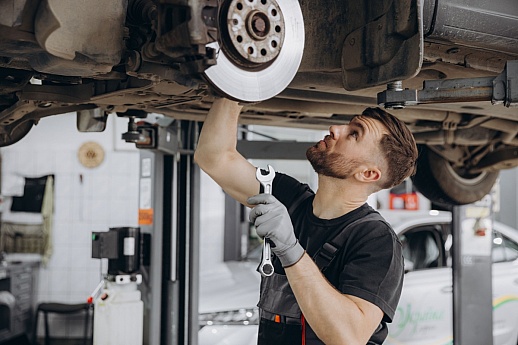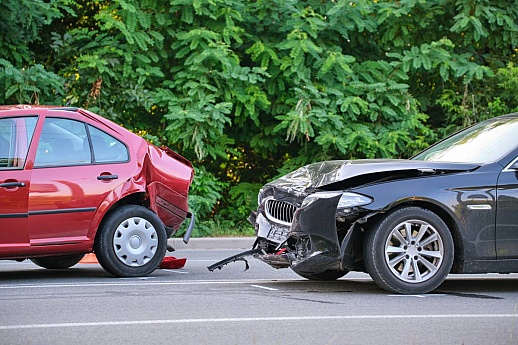Does Car Insurance Cover Vandalism?
Imagine walking out to your parked car only to find it vandalized and unrecognizable. The sleek paint job is now scratched, windows shattered, or worse, parts of it missing entirely. It's a scenario no one wants to experience, yet it happens more often than we'd like to think. But what really counts as car vandalism?
Vandalism spans a wide array of actions, all designed to alter or harm a vehicle deliberately. They're targeted attempts to damage property, often leaving car owners with hefty repair bills and a slew of questions about insurance coverage.
So, what do you do if your car is targeted by vandals? And perhaps more importantly, how can you protect your vehicle from becoming a target in the first place? This blog provides you with the knowledge to navigate the aftermath of car vandalism and the steps to mitigate future risks.
What Is Considered Car Vandalism?
Vandalism is any deliberate action meant to damage or deface a vehicle. This kind of behavior can range from minor to serious damage, all aimed at harming the car's appearance, functionality, or both.
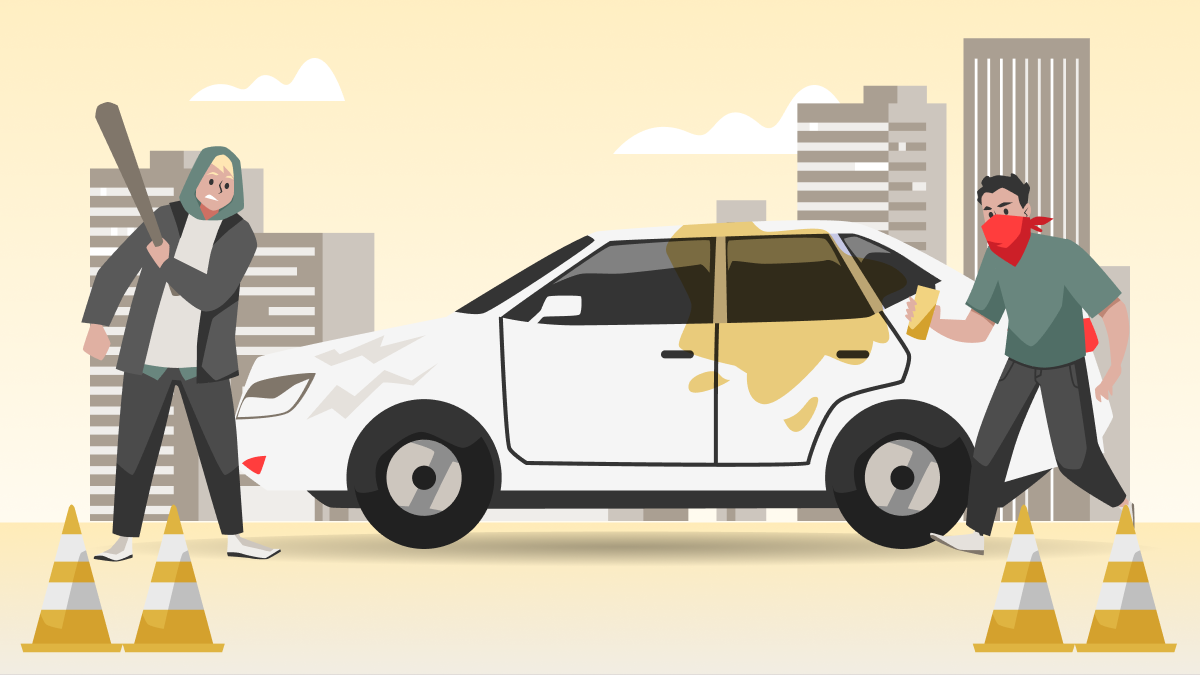
Here are the most common types of vandalism your car might fall victim to:
- Scratching or Keying: Involves dragging a sharp object, such as a key or a rock, across.
- Tire Slashing: Vandals may slash all or some tires, making them flat and the car immovable until the tires are replaced.
- Breaking Windows: Throwing rocks or using tools to break the car's windows leads to costly repairs.
- Graffiti: Spray painting the car with words, symbols, or images can permanently damage the paint if not quickly removed.
- Egging: Throwing eggs at a car can seem harmless, but the egg whites and yolk can damage the paint finish if not cleaned off promptly.
- Sugar in the Gas Tank: There's a myth that sugar can ruin an engine by turning it into a gummy mess, but more often, it's about the hassle and cost of cleaning or replacing the fuel system.
- Denting or Bending: Intentionally denting or bending parts of the car, like side mirrors or antennas, either by hand, with tools, or by kicking.
- Acid Attacks: Using acid or other corrosive substances to mar the car's paint and surfaces, causing irreversible damage.
- Theft of Car Parts: Stealing parts of the car, such as the catalytic converter, hub caps, or tires, can be both vandalism and theft.
- Gluing Locks: Inserting glue into the keyholes of car doors, making it impossible to unlock the car without professional help.
What to Do if Your Car Was Vandalized?
Discovering your car has been vandalized can feel like a personal attack, leaving you flustered and unsure of the next steps.
Here's how to navigate this unsettling situation:
- Document the Damage: Before you start cleaning up or making repairs, it's necessary to capture the state of your vehicle as is. Take comprehensive photos from multiple angles. These images serve a dual purpose: they are your immediate proof of the incident for both the police and your insurance company, and they help ensure that your claim encompasses all the damages.
- File a Police Report: It might seem like an additional step during a stressful time, but reporting the vandalism to the police is necessary. This report is an official record of the incident, lending credibility to your insurance claim. Provide specific details of the damage, the time frame in which the vandalism might have occurred, and any evidence you've collected, such as photographs or witness statements.
- Notify Your Insurance Company: The sooner you report the vandalism to your insurer, the quicker the claims process can begin. When you call, have your policy number ready and be prepared to describe the damage in detail, including when and where the vandalism occurred. Again, include any evidence you’ve gathered, such as photos or a police report, to support your claim. Refer to the "How to File a Vandalism Insurance Claim" section below for a comprehensive walkthrough of each step.
Before starting repairs, wait for your insurance claim to be reviewed and approved. Your insurer may need to inspect the damage or direct you to approved repair shops. If you begin repairs too soon, you might face costs not covered by your insurer. For urgent safety repairs, inform your insurance company and keep all receipts for reimbursement.
Does Car Insurance Cover Vandalism?
Car insurance can cover vandalism, but it largely depends on the type of coverage you have. If your policy includes comprehensive coverage, then yes, it likely covers any damage from vandalism. Comprehensive coverage is designed to protect you against various non-collision incidents, which means it kicks in for events like theft, natural disasters, falling objects, and vandalism.
Remember, even if you have comprehensive coverage, you'll probably have to cover the deductible first. This is the portion you're financially responsible for before your insurance starts to pay for the damages. Should the cost of repairs be less than your deductible, then you'll need to pay for the repairs entirely out-of-pocket.
On the other hand, if you have liability-only coverage, you're out of luck when it comes to vandalism. Liability coverage pays for other people's injuries or damage if you're at fault in an accident. It does not cover any damage to your own car, whether from a crash you caused or from vandalism.
Types of Car Vandalism Covered by Insurance
Vandalism can leave your car in less-than-perfect shape, but with comprehensive insurance, you might be covered for repairs.
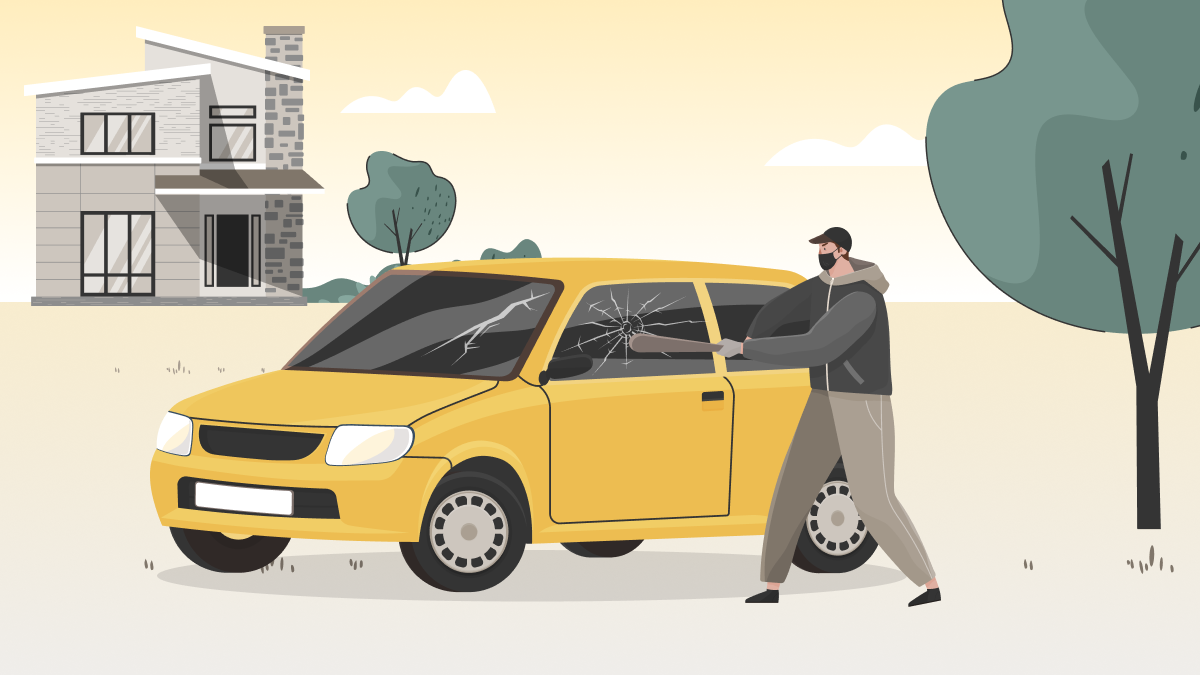
This section breaks down the repairs typically needed for common acts of vandalism, ensuring your car returns to its pre-damage condition:
- Scratching or Keying: Repairing this damage usually involves sanding the affected area, applying a new coat of paint, and possibly finishing with a clear coat to match the car's original appearance.
- Tire Slashing: Slashed tires need to be replaced entirely. Insurance may cover the cost of new tires and their installation.
- Breaking Windows: Broken windows will be replaced with new glass. The process includes removing shattered glass, installing new windows, and ensuring they function properly with the car's mechanics.
- Graffiti: Removing graffiti might require professional detailing, where special solvents are used to remove paint without damaging the car's original paint job.
- Egging: This requires a thorough cleaning, potentially including professional detailing, to ensure that all egg residue is removed to prevent paint damage.
- Sugar in the Gas Tank: This situation often requires draining and cleaning the fuel tank and fuel system to remove any sugar or contaminants.
- Denting or Bending: Depending on the severity, dents can sometimes be popped out or may require filling, sanding, and repainting. Bent parts like mirrors or antennas might need to be replaced.
- Acid Attacks: Repairing acid damage could involve sanding down the affected area to the bare metal and repainting or, in severe cases, replacing entire panels.
- Theft of Car Parts: Replacing stolen parts like catalytic converters, hubcaps, or tires involves purchasing new parts and installing them on the vehicle.
- Gluing Locks: A locksmith may need to clean or replace the lock mechanism to ensure the keys can once again operate the locks.
Do You Have to Pay a Deductible If Your Car Is Vandalized?
You'll usually have a deductible to pay before your coverage starts paying out. This deductible is the amount you agree to pay out of pocket when you file a claim.
The amount of deductible in car insurance can vary widely, influenced by the details of your policy and your choices when setting it up. Deductibles typically range between $100 and $2,000, which can significantly influence your upfront costs in the event of vandalism.
Opting for a higher deductible might lower your monthly premiums, but it means paying more out of pocket in the event of vandalism. Conversely, a lower deductible increases your premium but reduces the amount you need to pay when filing a claim.
How to File a Vandalism Insurance Claim
If the damage to your car is minimal, you might choose to forgo filing a claim with your insurance company and pay the repair costs out of pocket. However, if you have extensive damage that is covered under your comprehensive coverage, it is best to submit a claim.
Here’s how to file a vandalism claim:
- Initiate the Claim: Start by contacting your insurance company as soon as possible after the vandalism occurs. You can usually do this through a phone call, online, or using the insurer's mobile app, depending on what options your insurance company offers.
- Provide Information: Be prepared to provide details about the incident, including the date and time it happened, the type of vandalism, any photos of the damage, and a
- Review Your Policy: It’s important to review your policy for specific exclusions that might affect your claim. Common exclusions in vandalism cases include damage done by someone listed on your policy, wear, and tear mistaken for vandalism, or damages that exceed your policy limits. Understanding these exclusions and your policy's details, such as your deductible, will clarify what costs you might face.
- Work with a Claims Adjuster: Your insurance company will assign a claims adjuster to your case. This person’s role is to assess the damage, review the claim, and help determine the settlement. They might visit in person to inspect the car or request
- Submit Additional Documents: Depending on the situation, you might need to provide further information or documents. This could include repair quotes, a more detailed account of the incident, or additional evidence of the damage.
- Receive a Settlement Offer: After reviewing your claim, the insurance company will propose a settlement. The amount will be based on the adjuster’s assessment of the damage and your coverage. Settlement amounts can vary widely depending on the extent of the damage and your policy limits.
- Handle Repairs: Generally, it’s best to wait until the claim is settled before starting repairs to ensure the costs are covered. However, if you need to get repairs done immediately, keep all receipts and documentation. Some insurance policies allow for reimbursement, but you’ll need to check with your insurer.
How to Protect Your Car from Vandalism?
Protecting your car from vandalism is about taking proactive steps to make your vehicle a less appealing target for vandals.
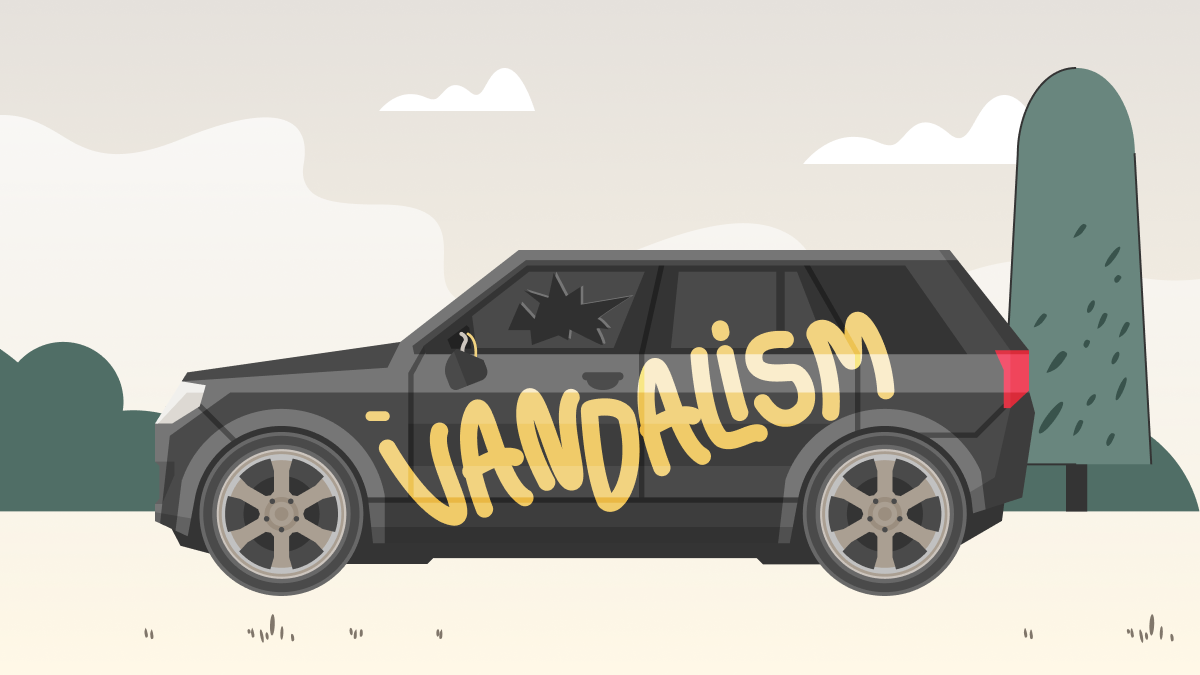
While it's impossible to guarantee your car will never be vandalized, these measures can significantly reduce the risk:
- Park in Well-Lit Areas: Darkness provides cover for vandals. Parking in bright, well-lit spots can deter someone from targeting your car.
- Use a Garage or Secure Area: Whenever possible, park your car in a garage or a secure parking area. This not only keeps it out of sight but also makes it more difficult for vandals to access.
- Install an Alarm System: An alarm can scare off vandals before they cause significant damage. Consider making the alarm sticker visible on your car window as a deterrent.
- Install Security Cameras: If you have a driveway, consider installing security cameras. The presence of cameras can be a strong deterrent, and if vandalism occurs, they can provide evidence.
- Install Motion Detection Lights: Adding motion-sensitive lights where you park your car can startle vandals by suddenly illuminating the area, making it less appealing for illegal activities.
- Keep Valuables Out of Sight: Valuables in plain view can tempt vandals into breaking into your vehicle. Keep your car interior clean and valuables hidden.
- Use Vandalism-Proof Accessories: To make your car a tougher target, consider investing in accessories like wheel locks, anti-theft devices for car parts, and shatter-resistant window films.
- Be Mindful of Where and How You Park: In public parking lots, try to park near the entrance or close to an attendant booth if available. Visibility can deter potential vandals.
Will a Vandalism Claim Affect My Premium?
Filing a vandalism claim can indeed affect your car insurance premium, but the impact varies depending on your insurer's policies, your claim history, and where you live.
Generally, after filing a claim for vandalism, you might see an increase in your premium. This is because insurance companies might view you as a higher risk, especially if you live in an area where vandalism is common or if you have filed multiple claims in the past.
Your premium will increase less significantly for a vandalism claim compared to collision claims. In many cases, you might see less than a $100 increase in your annual premium.
It's also worth noting that some insurance companies offer "forgiveness" policies for the first claim filed, meaning your premium wouldn't increase after the first incident of vandalism.
Bottom Line
Car vandalism is manageable with the right knowledge and steps. With the right protection in place, you can ensure that an act of vandalism doesn't leave a permanent mark on your life or your wallet. Stay informed, stay protected, and drive with peace of mind.
FAQ
Here, we aim to address some of the most common inquiries to help you overcome the aftermath of car vandalism.
Does Full Coverage Insurance Cover Vandalism?
Yes, full coverage insurance typically includes comprehensive coverage, which covers vandalism. If your car is vandalized, your insurance can help pay for repairs or replacements. Remember, you'll likely have to pay a deductible first.
Can I Choose My Repair Shop After Vandalism, or Must I Use One My Insurer Suggests?
Most of the time, you can choose your repair shop. However, insurers may suggest shops they trust. Using a recommended shop can sometimes make the process smoother, but the choice might be yours.
What Happens if Vandalism Occurs in Another State from Where My Policy Was Issued?
Your comprehensive coverage applies no matter where the vandalism occurs in the U.S. Always report the incident to your insurer as soon as possible for guidance.
Will My Rates Go Up More If My Car is Vandalized Multiple Times?
Multiple vandalism claims can lead to higher rate increases because insurers might view you as a higher risk. It's important to take steps to protect your car and possibly discuss preventive measures with your insurer.
Is There a Time Limit for Filing a Vandalism Claim?
Yes, insurers usually set a time limit for filing claims after an incident, often within 30 days. Check your policy or contact your insurer for the specific timeframe.
Does Vandalism Coverage Include Personal Items Stolen From My Car?
No, comprehensive coverage does not usually cover personal items stolen from your car. These may be covered under homeowners’ or renters’ insurance policies. Although, it may be worth checking with your insurance company just in case.
What Should I Do if the Cost to Repair the Vandalism is Close to My Deductible?
If the repair cost is close to or less than your deductible, it might not be worth filing a claim. Paying out of pocket could be more cost-effective in the long run, helping you save on car insurance by avoiding potential increases in your premium.
If My Car is Totaled By Vandalism, How is Compensation Determined?
If vandalism damages your car beyond repair (totaled), your insurer may pay you the actual cash value of your car minus your deductible. The actual cash value is your car's market value just before the damage occurred. You would not get to keep your car.
Can Installing a Dash Cam Help with My Vandalism Claim?
Yes, a dash cam can provide valuable evidence if your car is vandalized, potentially making it easier to file a successful claim. Some insurers might also offer a discount for having one.
Sources
Popular Mechanics. "Can Sugar Destroy a Car's Engine?" Accessed April 1, 2024.
WikiHow. "3 Ways to Report a Crime to the Police." Accessed April 1, 2024.
WikiHow. "3 Ways to Get Spray Paint off a Car." Accessed April 1, 2024.
Security.org. "How to Install Security Cameras in Your Home." Accessed April 1, 2024.

